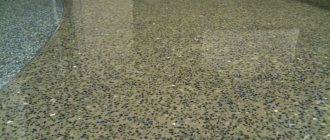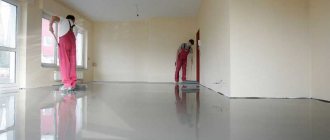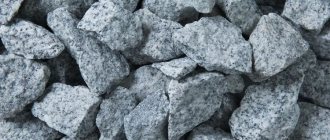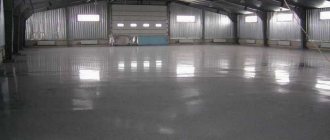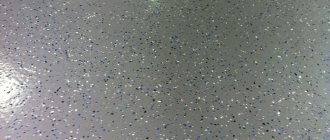On an industrial scale marble chips And marble crushed stone It is most widely used in the manufacture of self-leveling concrete mosaic floors, which are characterized by high decorativeness and performance properties (wear resistance, resistance to fading, environmental friendliness).
The decorative texture of a terrazza floor is obtained by adding colored mineral fillers (marble or stone chips) to the concrete mass. After hardening, the surface is ground and, if necessary, coated with hardening impregnations.
Self-leveling single-color and multi-color concrete mosaic floors are used in public places:
- shopping centers and stores
- office and business centers
- educational and medical institutions, etc.
Laying a mosaic floor is also allowed in industrial premises, based on the requirements for the operating conditions of the floor and the use of certain mineral fillers that provide the required level of physical and mechanical properties. Using modern concrete processing technologies, strengthening impregnations and sealants, it is possible to obtain highly decorative and durable coatings with increased performance characteristics.
Technology for pouring concrete mosaic floors
Mosaic (terrace) floor consists of two layers:
- the bottom layer (screed) is made of rigid cement-sand mortar grade 75 with a composition of 1:3 - 1:4 or low-grade concrete.
- the top layer (concrete-mosaic mixture) is made of cement mortar grade 100 with the addition of stone or marble chips. The thickness of the front layer is 15 - 20 mm.
Basic technological operations:
- preparation of the subfloor
- installation of slats/veins
- preparing mosaic mortar
- coating device
- grinding and polishing of mosaic coverings.
Price
| Floors with marble chips | |
| Minimum order for marble floors – RUR 120,000 | |
| industrial marble floor 30mm thick (from 300 sq.m.) | from 2.800r/sq.m. |
| decorative floor with marble chips | from 7,000r/sq.m. |
| steps with marble chips | individually |
The price list shows the price per m2 of marble flooring without complex artistic solutions (monolith, in one color). The cost of decor is discussed additionally. Also, the price depends on the coverage area, configuration and purpose of the room. The materials used as a base are also important - it can be concrete or a polymer composition.
We provide discounts for large projects.
Foundation of the future floor
The basis of the future mosaic floor can be:
- concrete base layer
- reinforced concrete interfloor slabs
- cement-sand screed.
It is necessary to make sure that the base is strong, rigid and has a grooved surface to improve adhesion to the self-leveling floor.
If there are cracks, potholes or various chips, they are embroidered, primed and sealed with a repair compound. It is also necessary to carefully seal all holes around pipelines and technological equipment, since their sealing in the finished mosaic coating is unacceptable.
The slope of the base or its horizontalness must comply with the standards. Due to the fact that the thickness of the mosaic layer is only 15 - 20 mm, it cannot be used to correct base defects.
Immediately before laying the mosaic covering, the base is washed with water.
Where is it used?
Just like regular marble, artificial concrete marble is used in the manufacture of building cladding, interior finishing components, and landscape planning. This is a durable finishing material that can withstand temperature changes, therefore it is widely used in park architecture: decorating fountains, creating mosaic patterns on paths.
But marble concrete is suitable for interior work:
- decoration of residential premises;
- creating the appearance of fireplaces - cladding;
- replacing ceramic tiles, especially in baths, toilets, and kitchens;
- shaping the floor covering;
- creation of stairs, window sills, railings.
Such products look good as floor coverings.
The material can be used for exterior decoration of fireplaces.
Installation of slats/veins
Terrace covering can be single-color or multi-color.
For a single-color floor, beacon slats are installed on the base every 1 - 1.5 m. The slats can be replaced with gas pipes with a diameter of 25 mm.
Multi-color mosaic coating is made according to a pattern specified by the project or developed based on available materials. In this case, an ornamental marking is applied to the base, along which the gasket (vein) is installed on the edge. The separating veins are made from strips of glass 3 - 5 mm thick, brass, aluminum or polymer materials. The top of the veins is carefully aligned so that it is level with the finished floor. The veins are fixed with cement mortar or slightly recessed in a freshly laid screed under the mosaic layer.
Marble concrete - requirements for artificial material
A difficult task is to recreate natural marble, which is a textured material distinguished by its unique structure, non-standard colors and veining. Craftsmen, making marble-like concrete on their own, place a set of requirements on the artificial material.
The resulting composite should have maximum similarity to a natural mineral:
- match the color scheme;
- have a similar structure;
- match in strength;
- maintain integrity during temperature changes;
- do not collapse at high moisture concentrations;
- not have a negative impact on others.
One of the main requirements is the minimum level of cash costs associated with the production of the composite. Proven technology (do-it-yourself marble from concrete) allows you to create a composite privately. At the same time, it will fully comply with the requirements.
Preparation of mosaic mortar
Decorative flooring is made from mosaic (terrace) mortar, which is prepared from cement of a grade not lower than M 400 and stone chips from polished rocks (marble, granite, labradorite, etc.).
The composition of solutions for finishing coating of self-leveling concrete mosaic floors includes:
- astringent
- mineral flour
- decorative fillers
- pigments.
Astringent
The basis for the mosaic mortar or binder is Portland cement of a grade not lower than M 400.
For gray and dark coatings, ordinary gray Portland cement is used. For floors with increased decorative qualities, white Portland cement (GOST 965–78) or colored Portland cement (GOST 15825–80) are used. In other words, cement of the color required for the specified color and pattern of the finished self-leveling coating is introduced into the solution.
Mineral flour
A light coating can also be obtained by introducing whitening additives into gray cement; this operation in preparing a mosaic floor solution is called whitening.
Stone flour with a grain size of up to 0.5 mm is used as whitening additives. Most often, marble flour and other mineral dust-like fillers with a compressive strength of at least 20 MPa (200 kgf/cm²) are used. The choice of mineral depends on what strength and corrosion-resistant properties are required to impart to the finished mixture.
It should be taken into account that the whitening additive reduces the strength of the solution, so it is better to use white Portland cement or strictly regulate the volume of the additive.
The amount of marble flour used for clarification varies from 20 to 40% of the mass of cement and depends on what brand of cement is used. For example, for cement grade M 400, in order to avoid reducing the strength of the coating, no more than 20% marble flour is added.
Marble filler also serves as a compactor for the concrete mixture - filling voids, slowing down setting and preventing shrinkage, which improves the quality of the surface and leads to a reduction in the number of shrinkage cracks and easier release of bubbles.
Decorative fillers
Decorative fillers for concrete mosaic floors are marble chips or crushed stone of a fraction from 2.5 to 15 mm , as well as granite and other mineral chips.
The compressive strength of the aggregate must be at least 60 MPa (600 kgf/cm²).
Most often, crumbs obtained from crushing polished hard rocks (marble, granite, labradorite, basalt, etc.) are used. The particles, evenly distributed on the front surface of the coating, give mosaic floors a decorative effect. Marble and marble limestone aggregates are highly polished when finishing the coating. Their abrasion during operation occurs evenly. At the same time, hard rock aggregates (granite, gravel, gabbro) wear out less than cement stone, and over time the floors acquire a spongy and lumpy surface.
To prevent significant abrasion of the cement stone, its destruction under the influence of external factors, and reduce the process of dust formation on the concrete surface, it is recommended to treat the floors with hardening impregnations at the end of all work.
The grain composition of the stone chips determines the coating pattern. Coatings with coarse crumbs are more decorative. It is advisable to have 75 - 85% of the surface occupied by stone aggregates on a polished mosaic covering, and the rest by cement stone. Such coatings are highly decorative and abrasion resistant.
Marble chips used for terraz floors can be single-colored or multi-colored and divided into three groups according to grain size:
- large: 10 - 15 mm (MK)
- average: 5 -10 mm (MS)
- small: 2.5 - 5 mm (MM).
Both large and small stone chips should be added to the solution, since only large chips and cement provide a composition in which shrinkage cracks can appear. The amount of large chips should be 0.8 m³ per 1 m³ of solution, and the volume of small chips added should be 10 - 30% greater than the volume of voids in large marble chips.
Terrace mortar can be prepared from the following components (by volume): white, colored or gray cement grade 400 - 1 part; crumb MM - 1 part; MS crumbs - 1 part and MK crumbs - 1 part; water - 0.5 parts. The amount of water depends on the moisture content of the crumbs and can be slightly increased or decreased. Excess water sharply deteriorates the quality of the solution.
Pigments
To obtain colored solutions, it is better to use colored cements of red, brown, yellow, green and blue colors, produced by industry. If this is not possible, then it is recommended to use mineral dyes as dyes for concrete:
- ocher (yellow)
- iron minium and mummy (red-brown or red color)
- chromium oxide (green)
- ultramarine (blue)
- manganese peroxide (black), etc.
Pigments pre-mixed with dry cement (bleached gray or white) are added in a volume depending on their coloring ability, but not more than 15% by weight of the cement.
Pigments for painting mosaic compositions must be alkali-resistant, i.e., not change color due to the action of cement itself and other materials containing alkali. They must also have good coloring power and be lightfast.
The type of dye and its quantity depend on the color of the chips and the specified floor pattern.
To obtain a floor with uniform color shades, it is necessary to prepare dry mixtures of each color in the volume required for one room, in order to exclude the possibility of obtaining a different shade in the same area during the next batch.
From all of the above components, a solution is prepared manually on a striker (in a box). The mixture is mixed dry, achieving uniform distribution of large crumbs throughout the mass. Water is added gradually, preferably from a watering can, so as not to wash off the cement from the crumb grains.
Solid advantages
Concrete marble
If a person is not a snob, for whom natural marble is preferable only because it is a sign of luxury and wealth (that is, a reason for superiority over others), then he will definitely appreciate all the advantages of concrete marble. And this wonderful material has quite a lot of them. In short, the advantages of “concrete marble” are as follows:
- accessibility - as we have already said, artificial marble does not need to be transported from distant marble quarries, where it is not so easy to obtain, and therefore this material is many times cheaper and more accessible than natural material;
- environmental friendliness - not only of the material itself, which is as safe for others as natural stone, but of its production: the production of marble from concrete is practically waste-free;
- low thermal conductivity - thanks to this, artificial marble can not only perform finishing and aesthetic functions, but also serve as a good additional insulation;
- moisture resistance - allows the material to maintain its quality for a long time and perform certain protective functions;
- strength - thanks to the use of “heavy” grades of cement and special plasticizers, this characteristic of an artificial building material is in no way inferior to the strength of natural stone, especially since the strength of “concrete marble” can be further increased by using metal mesh reinforcement;
- ample opportunities for creativity - unlike natural marble, the color, size and shape of which are largely determined by nature, artificial marble has those properties that are set by the manufacturer during the manufacturing process (using fillers, additives, including colored ones, molding, etc.) P.).
In other words, marble made from concrete is practically not inferior in its quality characteristics to natural stone, and in some ways it even surpasses its “prototype”. Finishing with such modern building materials looks no less noble and aesthetically pleasing than finishing with natural stone, and sometimes gives the designer more opportunities for his creativity. And at the same time, it is distinguished by strength and durability, and also, importantly, a very reasonable cost.
Covering device
Concrete mosaic floor coverings are performed at an air temperature of at least 5 C°. This temperature is maintained until the strength reaches at least 50% of the design value.
As already mentioned, single-color mixtures of mosaic self-leveling floors are laid between the lighthouse slats in stripes one after another, similar to concrete ones. In places where the coatings adjoin the columns, roofing felt pads are installed. The laid mortar is leveled with a rake and spatula, checking the correct placement using the rule according to the beacon slats.
The mixture is compacted with vibrating slats; in places inaccessible to vibrating slats, the mixture is compacted with light tampers (weighing at least 10 kg) or manually with a roller.
Accumulated laitance is removed using scrapers with a rubber gasket in order to avoid the formation of a cement film on the surface. After compacting the solution, the surface is carefully leveled and smoothed.
The slats are removed by filling the furrows with the solution until it sets in strips. During the hardening period, the floor must be kept moist for 5 - 7 days, moistened once a day with water and covered with plastic film, matting or mats
Colored floor mosaic mixtures are laid as the veins are arranged, leveling and compaction is carried out along the veins, which are used as lighthouse slats.
Method of making artificial stone
The given technology of marble from concrete will allow you to obtain an appearance close to the original stone. The sequence of operations for the production of artificial stone includes the following stages:
- dry mixing. Using a clean container, mix Portland cement with sifted fine-grained sand, maintaining a 1:2 ratio. After finishing mixing, add multi-colored pebbles and marble chips, which are a filler, to the resulting mixture. The introduction of multi-colored filler will provide an original look to the concrete product;
- introduction of dye. Add pigment to the prepared dry mixture, the concentration of which should not exceed 1% of the total mass of the mixture;
- re-mixing. Using an electric drill with a special attachment, thoroughly re-mix all ingredients. The main condition for the natural appearance of the future product is its uneven coloring, ensuring the identity of natural stone, which has veins and spotted inclusions;
If artificial marble is produced in large quantities, you will have to purchase or rent a vibrating table
- compaction of the composition. Using a vibrating table or manually (by vigorous shaking), ensure that air is removed from the dry mixture;
- adding plasticizer and water. Using heated water, dilute the plasticizer in a container in an amount equal to 1% of the total volume of cement and 80% of warm water. Mix the mixture with a mixer until a plastic composition is obtained. Add the remaining water to the volume and stir the mixture again;
- filling. Pour the resulting mass into pre-dried, clean polyurethane molds. Pay attention to the horizontal position of the form before pouring;
- reinforcement. If the area is larger and the product needs to be strengthened, reinforce the array using pre-prepared steel wire. Carry out the strengthening operation after pouring the mixture into molds by immersing a wire in a concrete mass.
Cover the filled products with plastic wrap. Ensure that the array remains stationary for ten days. During this period, the concrete mass will acquire operational strength. The use of collapsible molds with a smooth wall surface will facilitate the process of removing finished products.
Using original forms of appropriate sizes and configurations, you can easily make a stylized marble window sill with your own hands, as well as facing tiles, balusters, columns and other products.
The main advantage of marble, for the production of which concrete is used, is the absence of the need for additional processing.
Physical and mechanical properties of concrete mosaic floors
The compressive strength of the bottom layer and mosaic coating must be at least 20 MPa (200 kgf/cm²).
If the technological process is followed correctly, concrete mosaic floors having gained all their strength properties should have the following technical characteristics:
- compressive strength of concrete - 30 MPa or 300 (kgf/cm²)
- tensile strength during bending - 5 MPa or 50 kgf/cm²
- frost resistance - at least 50 cycles
- water absorption - no more than 6%
- abrasion - no less than 0.94 g/cm²
Step-by-step instructions for making marble from concrete
Which technology is best used to make marble from concrete must be decided depending on the specific conditions of use. The basic principles are the same. Making artificial marble at home will look like this:
Table of approximate correspondence between class and grade of concrete.
- The first stage is preparatory. The mold (or molds) must be thoroughly washed and dried. It can be of any size: for example, it can be specially made in accordance with the required values for the kitchen wall. To prepare the solution, you need to mix the dry ingredients until smooth: sand, pebbles and cement. After receiving the composition, pour in almost all the water, add the plasticizing ingredient. Continue kneading until the mixture is as smooth as possible.
- Add the rest of the water, then the dye - it must be introduced in portions of different sizes, always in different parts of the container. In this way, uneven mixing of the solution and color is achieved, which makes the artificial material more similar to natural stone.
- Filling the mold with solution. When the dye disperses in thin veins throughout the cement mass, we can consider that the composition is finally ready. Now you can move on to the most important phase of the technological process. The mold should be placed on a smooth surface - this will help prevent bending of the walls and bottom. Pour the solution into it. Using a spatula, the edges of the mold are cleaned of excess sagging, which can affect the appearance and smoothness of the surface of the slab, then the surface is leveled as a rule and covered with polyethylene.
The larger the artificial stone slab, the more likely it is to break due to voids inside. Therefore, you should not neglect the use of a vibrating table, which will help make the structure more continuous. If it is absent or impossible to use, you should try not to remove the mixer from the mixture while mixing - this way fewer air bubbles will form.
Sanding and polishing the coating
5 - 7 days after installation, the terraz mortar acquires strength sufficient for further processing - grinding, as a result of which the cement film is removed from the surface of the coating and a floor pattern appears. If treated earlier, stone chips may fly out of the floor, leaving potholes.
Sequence of surface treatment of the self-leveling coating:
- stripping
- coarse and fine grinding
- polishing.
Before stripping, the floor is sprinkled with sand and moistened with water, after which it is treated with a grinding machine with carborundum stones. After stripping, the floor is inspected and any potholes found are filled with cement mortar of the appropriate color.
Grinding is performed in the same way as roughing, using abrasive stones No. 60 - 80 and No. 230 - 325, respectively, for coarse and fine grinding. The floor is not covered with sand.
For high-quality finishing, polishing is used. To do this, after fine grinding, the floor is polished with M-28 stones and polished with felt wheels, adding polishing powder, followed by rubbing the surface with wax paste.
Production of artificial marble
Mini-factory for the production of marble from concrete.
Natural marble is a stone with heterogeneous colors, a granular structure, and with veins running through the entire thickness. The stone can be pink, blue or snow-white, gray or black. Other colors are also found: green, red, yellow, purple. You can create a material that imitates marble from gypsum: the result is a dense mass, devoid of pores. But this method will not work if the product is planned to be used in a room with high humidity. You can consider alternative methods that make it possible to make marble yourself.
The simplest technology is that concrete marble is cast in molds from a mixture of sand and cement. It turns out to be very strong, impermeable to moisture, and looks very much like the real thing. But it must be taken into account that thin tiles will be fragile, and if you make them thicker, they will turn out to be too heavy. It is possible to make, for example, a tabletop from such an imitation stone, but the furniture must have a massive body that will allow it to withstand the considerable weight of the slab. You can also make a thin version, using a wooden tabletop as a basis.
In order to end up with a cast slab that is indistinguishable from real stone, you will need to stock up in advance on the materials and tools necessary for the work. It is necessary to have a mold made of polyurethane or other material, dyes and plasticizers, which will need to be mixed with the cement mixture. For a construction mixer, you will need a mixer and drill attachments, as well as a short rule, a spatula.
Means for protecting and caring for mosaic floors
To increase the service life of concrete floors, improve strength properties, make the surface easier to clean, as well as enhance the texture properties of the floor, it is recommended to treat the surface with special liquid compounds for concrete:
- strengthening impregnations
- sealants
Strengthening impregnations are used to increase the strength of the floor surface several times. Their use almost completely eliminates the process of dust formation and protects the surface from the effects of aggressive liquid media.
Impregnations can be used to treat new and old terraz flooring.
Special varnishes are often used as a sealant for the final protection of concrete mosaic floors. Varnishes allow you to further strengthen the surface, reduce the process of dust formation and protect concrete from the penetration of chemically active liquids and moisture, which can destroy the cement matrix, and are also used to give the coating additional gloss or to obtain the effect of “wet floors”. The varnish creates a protective film on the surface, clogs pores and microcracks, which, together with surface protection, allows you to enhance color shades and emphasize the textured properties of the mosaic floor.
Uses of Concrete Marble
Imitation of natural marble is used quite widely: in the exterior decoration of residential buildings, in landscape design, and in the creation of columns, balustrades, for the design of sidewalks, fountains, in the framing of flower beds and vases.
Concrete products have many advantages, which are difficult to dispute. This is, first of all, accessibility for a wide range of consumers with a wide range of incomes. The material turns out to be very lightweight - it can be used for cladding walls, inclined surfaces located at a certain angle. It will not require additional processing. Both the thickness and shape of the tiles can be set in advance. During manufacturing, you can also create a relief surface with impeccable smoothness. Most often, the front part of the product is stylized as brick, wood, or sea ripples. The resulting slabs are connected like puzzles, which creates good conditions for high-quality coupling of elements, and this will provide the entire layer with greater reliability. In addition to different shapes, artificial marble slabs can be given a variety of colors and shades during manufacturing.
Business: how to open your own production?
To open your own business for the production of Marble from concrete, you need not only knowledge of the theory and understanding of the pellet vibratory casting process, but also practical skills in carrying out all stages of working with concrete - both manually and using equipment.
The LOBAS production company is always ready to help you implement your business plan for opening a fully functioning enterprise. We teach various vibration casting technologies, such as Marble from concrete, Kevlar concrete, Ultra concrete, Granilite. Our products, made to resemble marble stone, have been a competitive product since 2005 and are in steady demand in the sales market.
To find out the necessary information about taking a training course or to purchase it, we advise you to contact our specialists by phone. They will answer in detail all your questions regarding training or purchasing products made using Marble concrete technology.
Concrete imitating marble is in high demand almost everywhere. Vibration casting of products using the Marble concrete technology not only allows you to create unconventional products of decent quality, but also makes it possible to organize an operating full-function enterprise in your city.
Production technology
After preparing all the necessary components, you should begin preparing the mixture. All work is done in a clean container. The mixing solution has standard proportions of 1 to 3 parts. Fine sand is added to dry cement, which is pre-screened.
This must be done through a fine mesh so that the solution is homogeneous in consistency. Then the filler is mixed. Small pebbles or crushed stone are most often used as it. In addition, you can use crushed expanded clay, pumice or ceramic chips.
Creating Color
According to the technology, a coloring pigment is added to the finished solution. It does not need to be thoroughly mixed. On the contrary, in order for the artificial stone to be more like a natural mineral, the composition should be made as heterogeneous as possible. Paint of several shades is often added to create an unusual pattern on the poured object. Various bends, streaks, convolutions, dots or spots may appear on it. At this stage, you can give free rein to your imagination. Mixing colors in a variety of ways can lead to unexpected results. The amount of pigment should be 1% of the dry mass.
After introducing the pigment into the solution, it must be shaken thoroughly. Typically a vibrating table is used for this. For frequent use, you can make it yourself. But if the artificial stone is being made for the first and only time, then just shake the resulting mixture with your hands.
Adding water
Next, water is added at a rate of one to two in relation to the dry component. First, about 80% of the solvent is poured in, everything is thoroughly mixed. Then a plasticizer is introduced, which serves to enhance the strength of the future object.
This element must constitute at least 1% of the total mass. Mix everything again and leave it alone for a few minutes. The material becomes plastic and viscous. After this, the remaining 20% of water is poured in and distributed throughout the composition.
Creating a Form
Then the prepared solution is poured into pre-prepared molds. Cover it with plastic wrap on top and leave until completely hardened. To increase the strength of the material, a metal reinforcing mesh is placed in the liquid mixture.
After hardening, the finished panels are removed from the molds and subjected to thorough sanding. For this purpose, special equipment with diamond discs can be used. After treatment, the surface becomes even and smooth.
The manufacturing technology must be strictly followed. If you skip any stage, marble from concrete may not meet the quality.
Before installing the manufactured panels, it is necessary to prepare and clean the surface on which the installation will be carried out from climatic precipitation. This must be done with special care.
Various materials and products made from cultured marble made from concrete are considered to be as attractive, elegant, durable and durable as similar items made from real natural rock. The production of this product in Russia first began more than 30 years ago, during which time it has been improved and reached a high level. It copies the appearance of the stone so accurately that the untrained eye cannot distinguish the imitation.
